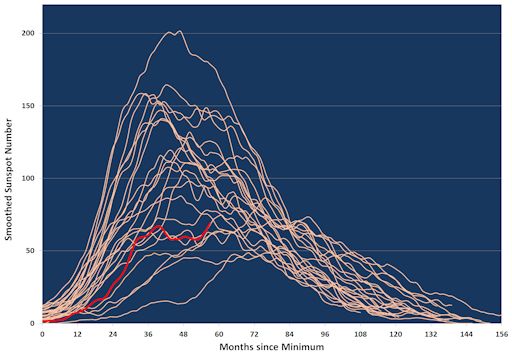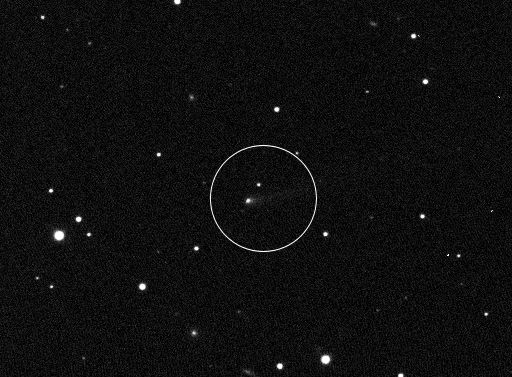Listen to radar echoes from satellites and meteors, live on listener-supported Space Weather Radio. | | |
SOMETHING BREWING IN THE PACIFIC? According to data from the NASA/French Space Agency Jason-2 satellite, something is brewing in the Pacific. Researchers say it could be a significant El Niño with implications for global weather and climate. Get the full story from Science@NASA.
SOLAR 'MINI-MAX': Last month at the Space Weather Workshop in Boulder, Colorado, solar cycle expert Doug Biesecker of NOAA announced that "Solar Maximum is here, finally." According to his analysis, the sunspot number for Solar Cycle 24 is near its peak right now. Spoiler: It's not very impressive. "This solar cycle continues to rank among the weakest on record," says Workshop attendee Ron Turner of Analytic Services, Inc. To illustrate the point, he plotted the smoothed sunspot number of Cycle 24 vs. the previous 23 cycles since 1755:

In the composite plot, Cycle 24 is traced in red. Only a few cycles since the 18th century have have had lower sunspot counts. For this reason, many researchers have started calling the ongoing peak a "Mini-Max."
"By all Earth-based measures of geomagnetic and geoeffective solar activity, this cycle has been extremely quiet," notes Turner. "However, Doug Biesecker has presented several charts showing that most large events such as strong flares and significant geomagnetic storms occur in the declining phase of the solar cycle."
In other words, there is still a chance for significant solar activity in the months and years ahead. Let's just hope it is not too significant. Solar flare alerts: text, voice
Realtime Space Weather Photo Gallery
FAINT COMET, BRIGHT METEOR SHOWER: On May 24th, the heavens could put on a display of irony. Forecasters say Earth is about to cross a stream of debris from Comet 209P/LINEAR, and the encounter could trigger a bright new meteor shower. The ironic thing is, the comet is so faint:

Aaron Kingery of NASA's Meteoroid Environment Office took the picture on May 18th using a 0.5 meter telescope at the Marshall Space Flight Center. "209P is not a very photogenic comet," says Kingery. "This is the best I could do with a 60-second exposure."
How could such a dim comet produce a bright meteor shower? In 2014, 209P is producing very little dust. However, the debris Earth is about to encounter didn't come from 2014. It was shed by the comet mainly in the 19th and 20th centuries. In those days, forecasters hope, the comet was more active.
We will find out this weekend. If a magnificent meteor shower erupts on Saturday morning, it will be safe to say that the comet wasn't always so underwhelming. Get the full story and observing tips from Science@NASA.
Realtime Aurora Photo Gallery
Realtime Mars Photo Gallery
Realtime Comet Photo Gallery
Every night, a network of NASA all-sky cameras scans the skies above the United States for meteoritic fireballs. Automated software maintained by NASA's Meteoroid Environment Office calculates their orbits, velocity, penetration depth in Earth's atmosphere and many other characteristics. Daily results are presented here on Spaceweather.com.
On May. 19, 2014, the network reported 5 fireballs.
(5 sporadics)

In this diagram of the inner solar system, all of the fireball orbits intersect at a single point--Earth. The orbits are color-coded by velocity, from slow (red) to fast (blue). [Larger image] [movies]
Potentially Hazardous Asteroids (
PHAs) are space rocks larger than approximately 100m that can come closer to Earth than 0.05 AU. None of the known PHAs is on a collision course with our planet, although astronomers are finding
new ones all the time.
On May 19, 2014 there were potentially hazardous asteroids.
Notes: LD means "Lunar Distance." 1 LD = 384,401 km, the distance between Earth and the Moon. 1 LD also equals 0.00256 AU. MAG is the visual magnitude of the asteroid on the date of closest approach. | | The official U.S. government space weather bureau |
| | The first place to look for information about sundogs, pillars, rainbows and related phenomena. |
| | Researchers call it a "Hubble for the sun." SDO is the most advanced solar observatory ever. |
| | 3D views of the sun from NASA's Solar and Terrestrial Relations Observatory |
| | Realtime and archival images of the Sun from SOHO. |
| | from the NOAA Space Environment Center |
| | the underlying science of space weather |

